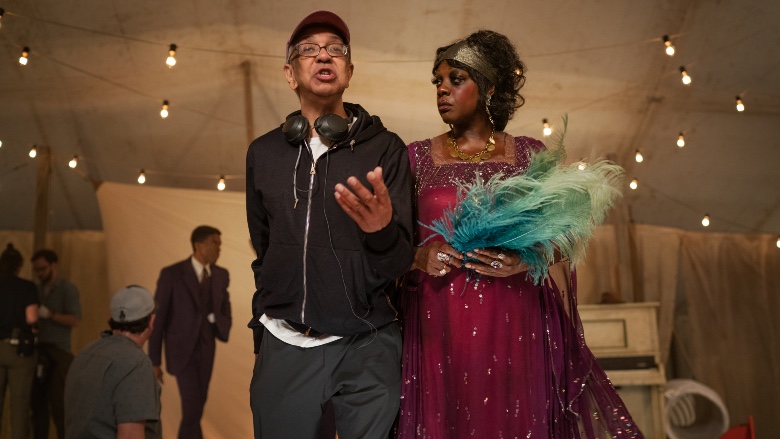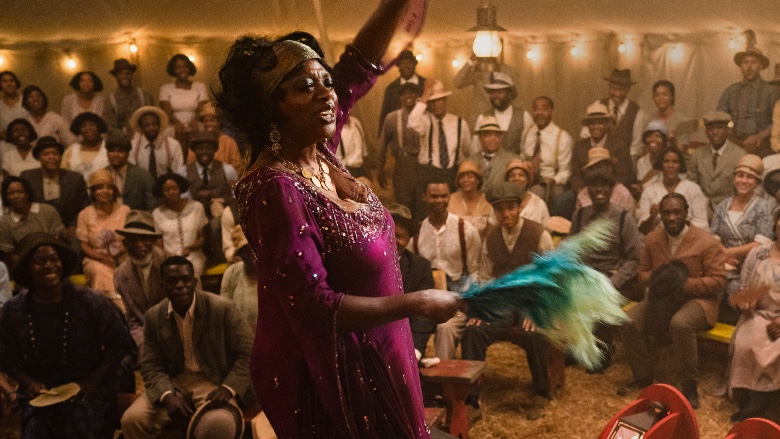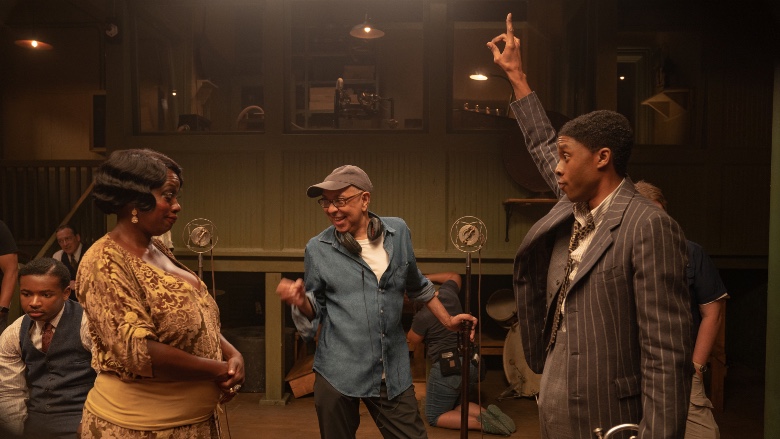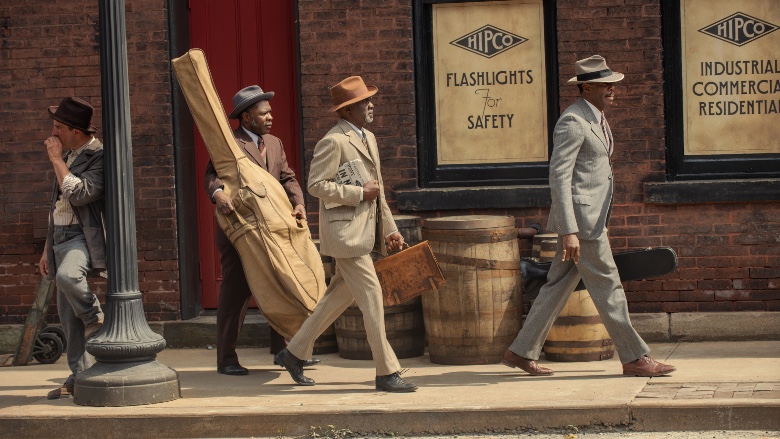
If you were to judge a director by the number of movies they’ve released into movie theaters, you’d be paying a huge disservice to Director George C. Wolfe, who has won multiple Tony, Obie and Drama Desk Awards for his stage direction as well as a Directors Guild award for directing the 2005 HBO television film, Lackawanna Blues. (He also received an Emmy nomination for that last one.)
With a career that has spanned nearly thirty years, Wolfe has only directed six films during that time, but his latest, Ma Rainey’s Black Bottom, adapted from August Wilson’s 1984 play, is going to make Wolfe far more in demand and may even put him into the Oscar race.
The title character of Ma Rainey, played by Viola Davis, is fashioned after the well-regarded “Queen of the Blues,” whose career in the early-to-mid 1920’s inspired so many other musicians and singers despite not getting nearly as much credit as her peers. In the film, Ma has come to Chicago to record some new records, but her ongoing conflict with her showboating trumpet player Levee (the late Chadwick Boseman), her manager and the record label’s white management leads to a less-than-desirable recording experience.
Below the Line spoke with Mr. Wolfe over the phone last week. Invariably, we got to talking about some of his craft collaborators like Cinematographer Tobias A. Schliessler, Production Designer Mark Ricker and Costume Designer Ann Roth.
Below the Line: I feel that this project came together fairly organically since Denzel Washington [one of the film’s producers] directed and co-starred with Viola Davis in Fences. I would assume you were friends with August Wilson or at least peers since you both were working on Broadway at the same time?
George C. Wolfe: No, I didn’t really… August and I were working in New York at the exact same time. I think he and I literally only met once, strangely enough. Denzel and I were talking, and he asked me to direct Ma Rainey. I knew Viola from New York… it’s all these New York connections. I’ve known Denzel for a long time, I knew Viola for a long time, and I knew August, but I knew him the least, if you will. At one time, he once asked me to direct a play of his, but he hadn’t written it yet, and I was tied up, because I was running the Public Theater at the time. So yes and no.
BTL: I don’t want to age you, but had you actually seen the original run of Ma Rainey’s Black Bottom on Broadway?
Wolfe: Absolutely. If you do have to age me, life is doing that quite well. I saw it at one of its final previews before it opened up back in 1984. Someone gave me a free ticket, I remember very specifically.

BTL: Did you connect with the material when you first saw it?
Wolfe: Yeah, I did. Charles Dutton was playing Levee, and it was this monumental, high up octane performance. That I remember very vividly. I remember Theresa Merritt was playing Ma Rainey, and it was a new voice. The dynamic that I remember most is the combustion of Charles Dutton’s performance, and that’s like 9,000 years ago, 1984. I was probably 29-30, something like that.
BTL: Had Denzel already been adapting the play when he asked you to direct?
Wolfe: I think he had been working on it before, and then once I got involved, for me, it was a clean slate, because I had to figure out how to make it work, so I dug in and started working with him, but also just sort of processing and ingesting the material and doing what I needed to do. Through the course of it, I ended up probably cutting hours’ worth of material out of it in order to adapt it into a film.
BTL: I’d be interested to know what you ended up cutting from the play.
Wolfe: A lot of the beginning parts of the script for the play, it was the guys in the band room telling these extraordinary stories but waiting for Ma to show up, so I made a decision that we needed to see Ma right away because her name is in the title, and I don’t want to spend time waiting on a character to appear. I wanted to see her, get to know her, know the dynamics in this, what I like to call “the prologue” that happens before the first dialogue happens, which is her in the South to the North, to her and Levee creating a rivalry on stage, and then going on from there. It was very important, and I also wanted to take advantage of the fact that except for the beginning and end of the film, it all takes place in one day. I love contrivances which very frequently are used in film is there’s a time crunch and so I wanted to intensify and magnify that equation as well.
BTL: That opening scene is pretty amazing in setting up the overall look of the movie with the costumes, the cinematography, but it also seems like that one scene that’s less than ten minutes could have added a ton of money to the budget.
Wolfe: It’s telling the audience hopefully every single thing they need to know, so that by the time characters literally start speaking, we know everything. We know that there’s a rivalry between Ma and Levee or there’s a rivalry with him. We know that he’s trying to subvert her authority. We know that he’s very ambitious. I don’t keep track of how much money gets spent, somebody else can do that. I’m just deeply invested in the storytelling, and also giving the audience all the information and the weapons they need, so they can relax into the story. So that’s what it really was about.
BTL: This was my first experience with this August Wilson play, but I moved to New York to work in recording studios, so I was pretty excited when I saw them recording Ma’s tracks to lacquer, which obviously isn’t something that’s been done in almost 100 years. Did you find a real studio to dress it up for the majority of the film or did you build it?
Wolfe: No, we had to build it, because we had to spend so much time in there, but isn’t that equipment extraordinary? I loved it. The weight, and that it takes three minutes for that weight to drop, which is why most of the recordings were three minutes.
BTL: I would guess that 90% of the audience wouldn’t understand what they’re watching in that scene.
Wolfe: But it’s one that actually functions, so even though they don’t understand the details of it, they understand the archaic nature and what it’s there to do, even though they won’t be able to analyze it. I loved the detail of how it was done – it was so endlessly fascinating to me.

BTL: Had you worked with Production Designer Mark Ricker before on something else?
Wolfe: No, this was our first time.
BTL: How did you work with him and his art team to design that studio, which also has a control room overlooking the studio, so it’s clearly well researched before they built it.
Wolfe: Ma recorded with Paramount Studios, and Paramount Recording, and historically, as I understand it, they had inferior equipment compared to some of the recordings that were happening in New York City at the time. It existed behind a chair manufacturing company in Chicago, so the idea that this was a repurposed room. It wasn’t built to be a recording studio. I had the idea that it would be a factory, and that elevated area was where the managers would sit up there and watch the workers working down below. The idea was that we would then take an old factory, as the head of the studio did, and turn it into a recording session. I wanted a sense, and Mark and I were very interested in the history of [it], so anytime you’re watching this visual, you’re seeing not only what it had become but a hint of what it was before it became what it became.
BTL: You mentioned in the Netflix documentary that there aren’t many pictures of Ma Rainey…
Wolfe: There are seven. Total. On the planet. Which is amazing. It shows how fragile, and here she is the quote-unquote “Mother of the Blues.” One of the things that’s been so thrilling to me about the response to the film is not just the response to everybody’s work, but it’s ignited an authentic curiosity about Ma Rainey and who she was and her music. So I’m very thrilled and very proud of that.
BTL: I was curious if there were any pictures of her in the studio or the studios at that time, because I’d sometimes ask if I had pictures of my studio days, and I’d just say, “No, we were working. No one was taking pictures.”
Wolfe: Exactly. You’re busy doing the thing. You’re not recording the fact that you just did the thing that you just did.
BTL: Tobias did an amazing job with the cinematography, something I definitely noticed on second viewing.
Wolfe: Extraordinary. We had a really glorious collaboration, and we worked extremely well together. I had a tremendous amount of fun working with him. I would say things like, “I live in New York City where in August, it’s so unbearably hot, you can almost see the heat.” In talking to him and then talking to visual effects, I said, “I want to be able to sese the heat.” The play was set in winter, and I wanted to set the film in summer just to magnify the intensity of the emotions that everybody was going through. I made the decision that the sky would never be blue — the sky would be white. It’s that horrible, ugly white, so that the sun didn’t become the white do in the white sky, just to make this place called Chicago so alien, and so odd to the people who have come there to record i.e. Ma and her band.
BTL: Was the outdoor scenes done on a backlot?
Wolfe: No, we did that in Pittsburgh – we filmed in Pittsburgh. The guys arriving on the El Train, that was crafted – the stairs descending were crafted by Mark – and we did the green screen work around it so that we can build up this whole industrial working class neighborhood. We found this one street in Pittsburgh, and once again, just found these fabulous cars and it was Pittsburgh dressed for 1927 Chicago.
BTL: Talking about the heat, that kind of leads to the makeup and hair for Viola and for Chadwick. They did such an amazing job, and they look so different, I’m not sure I would have known it was them going into it.
Wolfe: No, and the thing which was amazing is Ma Rainey had a horsehair wig in real life, so I felt with Anne Roth, we wanted a horsehair wig, so Mia [Neal], who did the wig, she found and bought some horsehair, which was covered in lice and manure, so she had to boil it. When she boiled it, it actually ends up softening the hair, which then in turn, she built the wig from horsehair strand by strand.

BTL: You can tell there’s an amazing amount of research involved.
Wolfe: Absolutely, and the entire crew was so ferociously dedicated to getting it right and putting forth the truth, because when you’re doing a period piece, the truth is in every single detail. And you can’t cheat on anything. It became really thrilling, because everybody was so invested. The actors were invested in embodying the truth, and everybody working on the project, from people making wigs, to props, to everything, was so invested in getting every single detail right. That’s one of the things that I love about film is that everything matters, everything matters.
BTL: When you watch it a second time, you really start noticing that stuff, so the movie has some great replay value, which I always enjoy.
Wolfe: Absolutely.
BTL: I have to ask about making the music and working with Branford Marsalis. Obviously, Ma Rainey was someone who had a huge impact on music, first on the blues but then also on rock ‘n’ roll. How did you work with him?
Wolfe: Bradford and I first worked together on my last film, which was Immortal Life of Henrietta Lacks, and that’s where he and I started our collaboration in many respects. The thing which I love about working with Branford is that in addition to being such a skilled composer, he’s also a musicologist. He’s a historian. When I first got involved, I said, “Okay, we need to find Levee’s sound, because Levee is the future. Ma is in many respects the past.” I got off the phone with him, and within an hour, he had sent me these recordings of all these artists who were the embodiment of what the future sound was. We just went on from there, because I would go digging for stuff, and then I mentioned it to him, and then he’d send me a compliment on the thing that I was digging for. It became this really great fun collaboration. I like digging into worlds and finding out as much as I possibly can about every single aspect of that world, and then you have somebody who is totally knowledgeable, is a musical historian, who would fill in any of the blanks and answer any of the questions that I had. It’s so thrilling when you have these collaborations that don’t have — for lack of better words — that aren’t bogged down by the effort of two people or two artists collaborating, but they have sort of the exhilaration of two artists collaborating.
BTL: And all of the actors actually learned the instruments they were playing?
Wolfe: They all had tutors. Chadwick, a very, very, very very driven actor wanted to know the exact fingerings, so Branford had someone do the fingering for all of the music that he was going to be playing, and he dug into it and evolved that. Sometimes, we’d be finished the song, and he was still playing it to try to show me that he was still growing with it. He wasn’t doing it to show off. He was just doing it, because he was just obsessive with getting it right. They worked very hard. We had a two-week rehearsal period in which I work with them on script and character and all this other stuff. While that was happening, they would leave rehearsals and go to their musical tutoring sequences.
BTL: I felt bad for the actor playing the upright bass, because that’s a tough instrument to have to lug around.
Wolfe: That was Michael Potts, and Branford said that by the time Michael showed up, he had learned every single thing. He played the bass – it was amazing.
Ma Rainey’s Black Bottom can be viewed on Netflix.
Photographs by David Lee.





